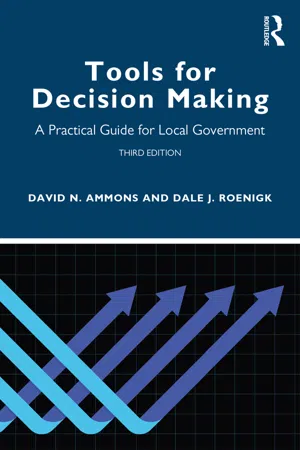
Tools for Decision Making
A Practical Guide for Local Government
- 400 pages
- English
- ePUB (mobile friendly)
- Available on iOS & Android
About this book
This book guides readers to the mastery of a wide array of practical analytic techniques useful to local governments. Written in an easy-to-read style with an emphasis on providing practical assistance to students, local government practitioners, and others interested in local government performance, this updated third edition features analytic methods selected for their relevance to everyday problems encountered in city and county governments.
The authors outline a variety of practical techniques including the simplest that the fields of management, public administration, policy analysis, and industrial engineering have to offer. Each analytic technique is introduced in the context of a fictitious case presented over a few pages at the beginning of that technique's chapter. Contents include demand analysis, work distribution analysis, process flow-charting, inflation adjustments, annualizing capital costs, staffing analysis, identifying full costs of a program or service, present value analysis, life-cycle costing, lease/buy analysis, cost-effectiveness analysis, benchmarking analysis, and more.
This updated third edition features a dramatic expansion of Excel-based applications, plus templates and exercises accompanying many of the chapters and available online. New chapters prepare readers to:
• use statistical tests to identify significant differences in performance averages;
• construct Pareto charts;
• develop cause-and-effect diagrams;
• prepare control charts;
• detect possible discrimination in hiring and appointment practices; and
• present analytic evidence more effectively.
This book is an essential resource for students and instructors of public administration courses on analysis, methods, evaluation, productivity improvement, and service delivery.
Online resources for this book, including Excel templates, are available at
https://toolsfordecisionmaking.sog.unc.edu
Frequently asked questions
- Essential is ideal for learners and professionals who enjoy exploring a wide range of subjects. Access the Essential Library with 800,000+ trusted titles and best-sellers across business, personal growth, and the humanities. Includes unlimited reading time and Standard Read Aloud voice.
- Complete: Perfect for advanced learners and researchers needing full, unrestricted access. Unlock 1.4M+ books across hundreds of subjects, including academic and specialized titles. The Complete Plan also includes advanced features like Premium Read Aloud and Research Assistant.
Please note we cannot support devices running on iOS 13 and Android 7 or earlier. Learn more about using the app.
Information
Part I Introduction
- knowledge of when to apply a given analytic technique
- skill in presenting analytic information
- awareness of the political environment in which decisions are made
- sensitivity to the concerns of public employees and decision makers
- a realistic perception of the place of analysis in a government setting
1 The role of analysis in local government
Analytic heritage
Table of contents
- Cover
- Endorsement
- Half Title
- Title Page
- Copyright Page
- Contents
- List of boxes
- List of figures
- List of tables
- List of worksheets
- Preface
- Part I Introduction
- Part II The basics
- Part III Analyzing a unit’s capacity to meet the demand for service
- Part IV What does it cost?
- Part V Process improvement
- Part VI Other analytic opportunities and techniques
- Part VII Presenting analytic evidence
- Part VIII Wrap up
- Appendix A. Distribution of chi-square
- Appendix B. Distribution of t
- Appendix C. Future value interest factors
- Appendix D. Sum of annuity factor (SAF)
- Appendix E. The normal distribution and table of z-score probabilities
- Appendix F. Excel’s data analysis ToolPak: Installation, use, and example
- Index